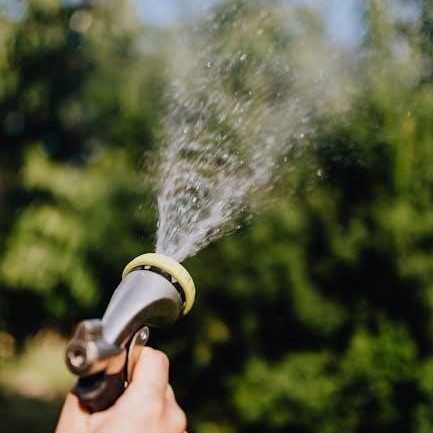Atwood Water Heater Manual PDF⁚ A Comprehensive Guide
This guide provides a comprehensive overview of Atwood water heater manuals in PDF format. These manuals are essential for understanding operation‚ maintenance‚ and troubleshooting‚ encompassing various models and ignition types. They detail safety precautions and installation guidelines specific to recreational vehicles.
Atwood water heaters are specifically designed for use in recreational vehicles‚ including travel trailers‚ fifth wheels‚ and motorhomes. These units come in two primary sizes⁚ 6 and 10-gallon capacities‚ catering to different needs. These water heaters are built to be installed on an exterior wall‚ with the access door opening to the outdoors. It is crucial to follow the manufacturer’s installation guidelines and safety precautions to ensure proper operation. The ignition system can vary‚ ranging from manual match lighting to piezo igniters and electronic ignition systems. These systems are engineered to provide reliable hot water for RV applications. Atwood heaters are not designed for positive grounding systems and should not be altered. Furthermore‚ avoid high-potential testing without disconnecting the electronic ignition circuit board. The thermostat allows for temperature adjustment‚ providing user control over the water temperature. Always refer to the appropriate manual for specific instructions and safety information.
Atwood Water Heater Models⁚ 6 and 10 Gallon Capacities
Atwood offers two primary water heater models distinguished by their tank capacity⁚ the 6-gallon and the 10-gallon variants. These models are designed to meet varying hot water demands within recreational vehicles. The 6-gallon model is suitable for smaller RVs or situations with lower hot water consumption‚ while the 10-gallon unit provides a larger capacity for more demanding needs‚ such as larger families or extended trips. Both models are designed for installation on an exterior wall‚ with access doors that open outwards for maintenance and ignition purposes. These units are built specifically for RV applications. The choice between a 6 and 10-gallon model will depend on the user’s specific requirements. Regardless of the capacity‚ all Atwood water heaters are designed to adhere to safety and operational standards. It is essential to refer to the relevant manual for detailed specifications‚ including dimensions and energy ratings‚ for the specific model.
Installation Guidelines for Atwood Water Heaters
Proper installation of an Atwood water heater is crucial for its safe and efficient operation. These units are designed for mounting on an exterior RV wall‚ with the access door facing outwards. It’s vital to ensure that all combustion air is drawn from outside the RV and that all combustion byproducts are vented to the exterior. Never vent the water heater into the interior of the RV. Modifications to the water heater are strictly prohibited‚ and never alter the unit for a positive grounding system. When installing‚ it is important to confirm that the mounting surface is sturdy and can bear the unit’s weight when full of water. Moreover‚ the area around the water heater should be free from obstructions‚ providing adequate ventilation and access for maintenance. Always disconnect the electronic ignition system before performing a high-potential (HI-POT) test. Adhering to these guidelines will contribute to the longevity and proper functionality of the Atwood water heater‚ ensuring safe operation during all uses. Always consult the specific installation manual for your model for detailed instructions.
Safety Precautions When Using Atwood Water Heaters
Prioritizing safety is paramount when operating an Atwood water heater in your recreational vehicle. Always ensure that the unit is installed correctly‚ following all manufacturer guidelines and adhering to local regulations. Never attempt any modifications or alterations to the water heater‚ as this can create hazardous conditions. Before using the water heater‚ confirm that the area around it is free from flammable materials and that proper ventilation is provided. If your unit uses a flame ignition‚ always start the ignition procedure outside the RV. If you smell gas‚ immediately shut off the gas supply and do not attempt to light the water heater until the leak is resolved. Regularly check the unit for any signs of damage‚ leaks‚ or corrosion. Never operate the water heater if it shows any signs of malfunction. If repairs are needed‚ only use genuine Atwood parts. If you have concerns about the unit’s performance‚ contact a certified technician. Following these precautions will help to ensure safe and reliable operation of the Atwood water heater‚ protecting both you and your property. Remember‚ safety always comes first.
Ignition Types⁚ Match‚ Piezo‚ and Electronic
Atwood water heaters utilize various ignition systems‚ each with its specific operational characteristics. The simplest is match ignition‚ where a flame is manually introduced to the burner using a match or lighter. This method requires direct access to the burner area‚ usually located outside the RV. Piezo ignition involves a built-in spark generator activated by a button or switch‚ creating a spark to ignite the gas. This provides a more convenient alternative to match lighting. Electronic ignition systems are the most advanced‚ using a control board to automatically ignite the gas burner when the thermostat calls for heat. These systems often include safety features such as flame sensing‚ which shuts off the gas supply if no flame is detected. Understanding the specific ignition system in your Atwood water heater is crucial for proper operation and troubleshooting. Each type has its own set of instructions and maintenance requirements detailed in the relevant manual. Always refer to your manual for safe and correct ignition procedures. Improper use can lead to safety hazards.
Temperature Adjustment and Thermostat Control
Atwood water heaters are equipped with a thermostat to regulate water temperature. This thermostat allows users to adjust the desired water temperature‚ ensuring comfort and preventing scalding. The adjustment mechanism may vary depending on the model‚ but often involves a control knob or dial. Turning the knob clockwise typically increases the temperature‚ while turning it counterclockwise decreases it. The thermostat maintains the set temperature by cycling the burner on and off as needed. Some models may have a temperature range clearly marked on the control panel. Precise temperature settings are essential for optimal performance and safety. It’s important to consult your specific Atwood water heater manual for the exact location and operation of the thermostat control. Additionally‚ the manual provides guidance on setting temperature limits and understanding how the thermostat interacts with the burner system. Overriding the thermostat or attempting to adjust it beyond its intended range can lead to malfunctions. Regularly verifying thermostat accuracy can prevent unexpected temperature fluctuations and ensure the water heater operates efficiently. Always follow the manufacturer’s instructions for safe and proper thermostat operation.
Warranty Information and Return Procedures
Atwood water heaters typically come with a limited warranty‚ often covering a period of two years from the date of purchase. This warranty generally protects against defects in materials and workmanship‚ including inner tank leaks due to corrosion. The warranty may include the replacement of defective parts or the entire water heater‚ along with reasonable labor charges. To initiate a warranty claim‚ you’ll likely need to provide proof of purchase and details about the issue. If returning parts or the entire water heater‚ they must be shipped prepaid to Atwood. Credit for shipping costs will be included with the warranty claim. Defective items become the property of Atwood Mobile Products and must be returned to their Consumer Service Department. It’s crucial to consult your specific Atwood water heater manual for detailed warranty terms and conditions‚ as well as the exact return address. The manual will also outline what is not covered under the warranty‚ such as damage caused by improper installation or misuse. Understand the warranty period and procedures to ensure a smooth claim process‚ should the need arise. Always keep your purchase documentation and follow the specified return instructions to avoid any complications with your warranty claim.
Atwood Water Heater Service Manual (2004 Edition)
The 2004 edition of the Atwood Water Heater Service Manual is a vital resource designed specifically for service technicians. This manual serves as a comprehensive guide to assist with identifying Atwood products by their serial numbers‚ enabling technicians to accurately diagnose service problems. It provides detailed instructions and troubleshooting procedures to efficiently and effectively address a variety of issues encountered in Atwood water heaters. Furthermore‚ the manual outlines the necessary steps for processing warranty claims‚ ensuring that technicians can handle these processes correctly. This manual is a key component in ensuring that repairs are done accurately and within the bounds of the warranty. It includes information on component identification‚ helping technicians pinpoint and service the correct parts. The 2004 edition is particularly useful for dealing with older Atwood models‚ offering insights and solutions based on the technology and components available at that time. Having access to this manual can significantly speed up diagnosis and repair times‚ saving both time and money. It’s a must-have for any technician working on Atwood water heaters‚ providing the specific information needed to handle service and warranty claims effectively.
Troubleshooting Common Issues
When dealing with Atwood water heaters‚ several common issues can arise‚ requiring a systematic approach to troubleshooting. One frequent problem is the lack of hot water‚ which can stem from various causes‚ such as a faulty thermostat‚ a tripped manual reset high-temperature limit‚ or an ignition problem. Another common issue is the inability of the heater to ignite‚ this can be caused by a malfunctioning piezo ignitor‚ or problems with the electronic ignition system including the circuit board. In certain instances‚ the water heater might produce lukewarm water instead of hot water‚ which could indicate a partially working heating element or issues with the thermostat. Additionally‚ problems may occur due to gas supply issues‚ where the flow of gas to the heater is either inadequate or cut off. Furthermore‚ leaks might be encountered‚ often due to corroded tanks‚ which may require replacement. The manuals often provide diagnostic procedures to help isolate the source of the issue. It is crucial to follow the manual’s instructions carefully‚ ensuring all safety precautions are observed when handling gas and electrical components. If the problem cannot be resolved‚ seeking professional assistance is advisable to prevent further damage or injury. Proper troubleshooting is vital for maintaining the efficiency and safety of Atwood water heaters.
Component Identification and Servicing
Understanding the various components of an Atwood water heater is crucial for effective servicing. Common components include the burner assembly‚ which facilitates the combustion of gas to heat the water‚ and the thermostat‚ responsible for regulating the water temperature. The heating element‚ present in electric models‚ directly heats the water. The igniter‚ whether piezo or electronic‚ initiates the combustion process. The gas valve controls the flow of gas to the burner‚ and the ECO (Energy Cut Off) acts as a safety mechanism‚ preventing overheating. The water tank is at the heart of the system‚ storing the heated water. Servicing involves several steps‚ including cleaning the burner and flue‚ checking for leaks‚ testing the thermostat‚ and ensuring proper gas flow. Proper identification of each part is essential before attempting any repairs. When servicing the electronic ignition system‚ it is important to disconnect it before performing any hi-pot testing. The manuals provide detailed diagrams and descriptions of each component‚ guiding technicians through the process. Incorrect handling of components can lead to further issues‚ so it is advisable to consult the service manual before undertaking any repairs. Safety precautions should always be followed when dealing with gas and electrical components during servicing. If unsure‚ it is best to seek help from a professional service technician.
Understanding Model Numbers and Specifications
Atwood water heater model numbers provide essential information about the unit’s specifications and features. Typically‚ these numbers indicate the tank capacity‚ such as 6 or 10 gallons‚ as well as the ignition type‚ whether it is match‚ piezo‚ or electronic. The model number also clarifies if the unit is a gas-only model or a combined gas and electric version. For instance‚ a model number might include letters like ‘GE’ for gas and electric‚ or ‘XT’ for models featuring advanced exothermal technology. Each model has specific dimensions‚ weight‚ and BTU ratings‚ which are important for installation and performance considerations. Understanding the model number allows users to consult the correct manual for their specific unit‚ ensuring proper operation and maintenance. The manuals detail the exact specifications‚ including the voltage requirements for electric models and the gas type compatibility. Some models have unique features or specific installation requirements‚ so cross-referencing the model number with the manual is crucial. This knowledge also assists in identifying replacement parts and troubleshooting issues effectively. Failure to correctly identify the model can lead to improper repairs and even safety hazards. Therefore‚ always refer to the model number when seeking information or service for your Atwood water heater. The manual will explain all the nuances of the specific series and offer the correct guidance.
Operation and Maintenance Instructions
Operating an Atwood water heater requires careful adherence to the instructions provided in the manual to ensure safe and efficient performance. Before use‚ verify that the water tank is completely filled to prevent damage. For gas models‚ ensure the gas supply is properly connected and that the vent is clear of obstructions. Ignition procedures vary depending on the model‚ with some requiring a match‚ piezo ignitor‚ or a remote switch for electronic ignition. During operation‚ monitor the water temperature and adjust the thermostat as needed‚ being mindful of potential scalding hazards. Regular maintenance is crucial for the longevity of the unit. This includes inspecting the burner assembly for any debris or corrosion‚ checking the anode rod for wear and replacing it as recommended‚ and cleaning the flue regularly to ensure proper ventilation. It is also important to periodically check the water lines for leaks and to ensure that the unit is free from any blockages. For electronic ignition models‚ verify that the circuit board and wiring are in good condition‚ and that connections are secure. The manuals often include specific guidance on winterizing the water heater to prevent damage from freezing temperatures. They also explain the proper procedures for draining the tank for storage or maintenance. Neglecting these instructions can lead to system failures and safety risks. Always consult the correct manual for your specific model for detailed maintenance guidance.
Manual Reset High-Temperature Limit
Atwood water heaters are equipped with a manual reset high-temperature limit switch‚ a critical safety feature designed to prevent overheating. This limit switch is activated when the water temperature exceeds a predetermined threshold‚ typically due to thermostat malfunction or other issues. When tripped‚ the switch interrupts the power supply to the heating element or gas valve‚ thus stopping the heating process. To reset this‚ you usually need to manually access the switch‚ which is typically located near the thermostat or ECO (Energy Cut Off) device. The process involves allowing the unit to cool down and then pressing the reset button. The specific location of the reset button is detailed in the Atwood water heater manual and can vary depending on the model. Incorrect resetting can cause further issues or damage the unit. Understanding the correct procedure is important for safety and effective operation. It is very important not to bypass the manual reset limit switch as this could lead to dangerous situations. If the switch trips repeatedly‚ it is an indication of a underlying problem that should be assessed and resolved. Consult the relevant section in the Atwood manual to determine the nature of the problem before attempting to reset. This could include thermostat issues‚ a faulty ECO device‚ or problems with the water flow. A professional service technician may be needed for complex repairs.



